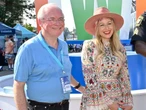As artificial intelligence transforms customer service and workplace tools, many companies still struggle to capture that elusive human connection. Chewy CEO Sumit Singh explains that a “moat” of human-led customer service was built around the Chewy brand so that it can compete in the evolving marketplace. Sarah Robb O’Hagan—a former executive of Gatorade, Equinox, and, most recently, Exos—calls for leaders to understand that employee life cycles are just as important as customer life cycles. Recorded live at the 2024 Masters of Scale Summit in San Francisco, both Singh and O’Hagan offer strategies for generating genuine loyalty.
This is an abridged transcript of an interview from Rapid Response, hosted by Robert Safian, former editor-in-chief of Fast Company. From the team behind the Masters of Scale podcast, Rapid Response features candid conversations with today’s top business leaders navigating real-time challenges. Subscribe to Rapid Response wherever you get your podcasts to ensure you never miss an episode.
Chewy has distinguished itself often by doing things that are very human and bespoke—these sort of moments of surprise and delight for customers like pet portraits and birthday cards. And I know that your healthcare business in pet services came from human interaction from your salespeople. I’m curious how you think about surprise and delight, building customer loyalty, and the ROI around trying to build loyalty?
Singh: What’s well understood is good service, good experience, costs less over time. If you start from that mentality, good experience builds loyalty. And if you agree with the postulate on the purpose of a brand is to acquire and retain customers, then retention and loyalty building is the closest correlation—I’d argue whether it’s causation or correlation—to building loyalty.
So you can buy dog food from anywhere. We’re in the business of selling dog food. But that’s not what makes the job fun. What makes the job fun is to recognize how empathetic this category is and how customers in this particular category treat their furry members as family.
And how do you build that empathetic connection? It’s unfortunate that over the last many years, customer service has become so bad that we’re actually excited by the prospect of talking to an AI chat agent.
Right, that seems like an improvement.
Singh: And I’m not saying that it doesn’t have a place. It does, and I’m going to come to that because it’s not just in the mentality; it’s in your culture. As you build companies, I want to appeal to you that customer experience or customer service can build loyalty that can create a defensive and offensive moat around your brand that allows you to compete against the larger stalwarts of the world, which we’ve been competing with for the last many years.
When I joined Chewy, it was a billion-dollar brand. This was seven years ago. Today, we clock 25% of North American households shopping at Chewy, and we’re a $12 billion brand. This is top line only, not market cap.
Well, I just want to note that not everyone may know this. So during the pandemic, when things were really tight and it was hard to get folks, Sumit was under a lot of pressure—like maybe you use more bots. He was like, no, we’re going with the humans. And his human folks brought him insights that said, “Hey, maybe we should start like veterinary care for pets,” and it spawned a whole new business. The things that humans bring to you sometimes are not what you expect.
Singh: Why do you want to talk through the IVR and figure it out for the first one minute, wait five minutes, and then get in queue for us to call you back? That’s ordinary. So we’ve gotten our arms around it. Now a customer calls, and in the conversation, the agent essentially says, “How did you name your dog Becky?”
The customer says, “It goes back to the Beyoncé song, Becky with the hair.” The call progresses normally. A few days later, the customer receives a custom-painted Beyoncé CD with her pet’s portrait painted on it. This is going above and beyond. What does that do? It creates conversations.
You’ll talk about this story. It gets talked about at dinner reservations, posted on social media: 250,000 reposts, 700,000 likes, etc., etc.
This traditional science of customer relationship marketing starts with doing the basics right. The basics was courtesy over process and efficiency, then making the ordinary extraordinary, and then truly going above and beyond what customers are expecting, right?
Sarah, you’ve worked with brands that engender a lot of loyalty at Exos, Equinox, JetBlue, where you’re on the board. You also worked at Nike. I’m curious about how the relationship you have and loyalty among your staff, your team, impacts how your loyalty builds with your customers.
O’Hagan: I love this question, Bob, because I think it’s so important. Like my early days in my career, I actually started at Virgin, the early Richard Branson days. And then Nike, where . . . we would just bleed the Swoosh, like people had tattoos who worked there, and we would shame anyone who worked with us who didn’t wear the product.
I remember when I began to lead Gatorade globally, which was part of PepsiCo at the time, it was financially struggling, and there were a ton of new employees coming on board. You were given a shopping list of PepsiCo products that you had to buy, and people hated it because they felt forced to do something as opposed to passionately believing they wanted to.
So I think there’s a huge correlation. When a team is so fired up about the culture you’ve built at Chewy, they’re going to have those moments where they want to delight the customer. It’s massive. In the business I’m in now, Exos, we are a human performance coaching company. We coach people just like you.
It’s interesting, going through the last years of the pandemic, everyone has been suffering from burnout and all these sorts of things. We spend as much time tracking how well our coaches are rated by their clients as we do on how they are feeling. Are they feeling like they are up for the job today? Because if they’re feeling awesome and great about the company, they are going to, in turn, want to deliver.
I feel like a lot of companies have values. Enron had values. But how do you make sure as a leader that those values are being lived? Are there things you have to do yourself?
O’Hagan: You can do it in every part of the employee life cycle. I think about the employee life cycle just as I do a customer life cycle.
By the way, I’m dating myself here, Bob, but when I was in college, we learned about the innovation adoption curve—the early adopters and the laggards. Employee culture is the same. You have to know who the mayors are, those engaged who spread the word for you. They are important in value and living the values.
Throughout the employee life cycle, when hiring someone, I go through our values and ask them to give examples from their life where the value came to life. Talk to me about how you perceive this at Exos. You’re truly making it a living document, not just something on the wall.
You have to bring it.
Singh: 100%. You have to hire for that. Identify the evangelists within those you try to hire, and lead by example. You have to put your money where your mouth is. I’ll give you an example: When you call us and have bought food or medication, we will say, “Don’t worry about returning it.”
Sometimes food doesn’t work out, or when your pet’s passed away. When food doesn’t work out, we say, “Go donate it to a shelter.” We’re putting our values of surprising and delighting you into practice. It’s also sometimes economically beneficial to do these things.
We’re building this connection by catching you off guard by allowing a donation to a shelter, refunding money. Yes, and you’ll talk about that. We have a 365-day return policy—no questions asked. It’s the most generous refund and return policy in the industry. Yes, we could reap tens of millions and float to the bottom line if we matched Amazon’s policy, but we don’t.






No comments